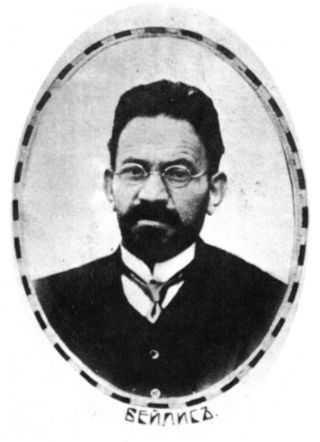
Blood libel or ritual murder libel is an antisemitic canard which falsely accuses Jews of murdering Christians in order to use their blood in the performance of religious rituals. Echoing very old myths of secret cultic practices in many prehistoric societies, the claim, as it is leveled against Jews, was rarely attested to in antiquity. According to Tertullian, it originally emerged in late antiquity as an accusation made against members of the early Christian community of the Roman Empire. Once this accusation had been dismissed, it was revived a millennium later as a Christian slander against Jews in the medieval period. The first examples of medieval blood libel emerged in England in the mid 1100s before spreading into other parts of Europe, especially France and Germany. This libel, alongside those of well poisoning and host desecration, became a major theme of the persecution of Jews in Europe from that period down to modern times.

John of Damascus or John Damascene, born Yūḥana ibn Manṣūr ibn Sarjūn, was an Arab Christian monk, priest, hymnographer, and apologist. He was born and raised in Damascus c. AD 675 or AD 676; the precise date and place of his death is not known, though tradition places it at his monastery, Mar Saba, near Jerusalem, on 4 December AD 749.

The Damascus affair of February 1840 was the disappearance of an Italian monk and his servant, for which a large number of Jews were summarily tortured until they "confessed" to murder. As an instance of antisemitism and a blood libel, news of the case spread, across the Middle East, to Europe, and the Western world.
Religious antisemitism is aversion to or discrimination against Jews as a whole based on religious doctrines of supersession, which expect or demand the disappearance of Judaism and the conversion of Jews to other faiths. This form of antisemitism has frequently served as the basis for false claims and religious antisemitic tropes against Judaism. Sometimes, it is called theological antisemitism.

Menahem Mendel Beilis was a Russian Jew accused of ritual murder in Kiev in the Russian Empire in a notorious 1913 trial, known as the "Beilis trial" or the "Beilis affair". Although Beilis was eventually acquitted after a lengthy process, the legal process sparked international criticism of antisemitism in the Russian Empire.

William of Norwich was an apprentice who lived in the English city of Norwich. He suffered a violent death during Easter 1144. The city's French-speaking Jewish community was blamed for his death, but the crime was never solved. William's case is the first known example of a medieval blood libel.

The siege of Acre of 1799 was an unsuccessful French siege of the Ottoman city of Acre and was the turning point of Napoleon's invasion of Egypt and Syria, along with the Battle of the Nile. It was Napoleon's third tactical defeat in his career, being defeated at the Second Battle of Bassano and the Battle of Caldiero three years previously during the Italian campaign, and his first major strategic defeat, along with the last time he was defeated in battle for 10 years. As a result of the failed siege, Napoleon Bonaparte retreated two months later and withdrew to Egypt.

Edmund Pevensie is a fictional character in C. S. Lewis's The Chronicles of Narnia series. He is a principal character in three of the seven books, and a lesser character in two others.

Gilad Atzmon is an Israeli-born British saxophonist, novelist, political activist, and writer.

Mustafa Abdul Qadir Tlass was a Syrian military officer and politician who was Ba'athist Syria's minister of defense from 1972 to 2004. He was part of the four-member Regional Command during the Hafez al-Assad era.

Alon Ḥilu is an Israeli novelist.

The history of the Jews in Syria goes back to ancient times. They were joined by a Sephardim who fled after the expulsion of the Jews from Spain and Portugal in 1492 CE. There were large Jewish communities in Aleppo, Damascus, and Qamishli for centuries. In the early 20th century, a large percentage of Syrian Jews immigrated to British Mandate-Palestine, the U.S. and Latin America.
Antisemitic tropes, also known as antisemitic canards or antisemitic libels, are "sensational reports, misrepresentations or fabrications" about Jews as an ethnicity or Judaism as a religion.
Raphael Levy was a Jewish inhabitant of the city of Metz who was burned at the stake, accused of having ritually murdered a Christian child, Didier Le Moyne. For some years after his execution, the Jewish community in Metz marked the anniversary of his death as a day of fasting.
This timeline of antisemitism chronicles events in the history of antisemitism, hostile actions or discrimination against Jews as members of a religious and ethnic group. It includes events in Jewish history and the history of antisemitic thought, actions which were undertaken in order to counter antisemitism or alleviate its effects, and events that affected the prevalence of antisemitism in later years. The history of antisemitism can be traced from ancient times to the present day.

Haim Farhi, was a Jewish adviser to the governors of the Galilee in the days of the Ottoman Empire, until his assassination in 1820.
The Rhodes blood libel was an 1840 event of blood libel against Jews, in which the Greek Orthodox community accused Jews on the island of Rhodes of the ritual murder of a Christian boy who disappeared in February of that year.

The 1834 looting of Safed was a month-long attack on the Jewish community of Safed in the Sidon Eyalet of the Ottoman Empire during the Peasants' revolt in Palestine. It began on Sunday, June 15, the day after the Jewish holiday of Shavuot, and lasted for 33 days. It has been described as a spontaneous attack on a defenseless population during the armed uprising against the rule of Ibrahim Pasha of Egypt, the Ottoman governor. The event took place during a power vacuum while Ibrahim Pasha was fighting to quell the wider revolt in Jerusalem.
Abdullah Pasha ibn Ali was the Ottoman governor (wali) of Sidon Eyalet between May 1820 and May 1832, with a nine-month interruption in 1822–23. Like his predecessors Jazzar Pasha and Sulayman Pasha, Abdullah Pasha ruled from the port city of Acre. During his reign, all of Palestine and the Syrian coastline came under his jurisdiction. Among his major military victories was his survival of an imperial-backed siege of Acre in 1822 instigated by the Farhi family in retaliation for Abdullah's execution of his mentor Haim Farhi, the suppression of revolts in Mount Lebanon and Jerusalem in 1824 and 1826, respectively, and the 1831 capture of the Sanur fortress.
This timeline of antisemitism chronicles the acts of antisemitism, hostile actions or discrimination against Jews as a religious or ethnic group, in the 19th century. It includes events in the history of antisemitic thought, actions taken to combat or relieve the effects of antisemitism, and events that affected the prevalence of antisemitism in later years. The history of antisemitism can be traced from ancient times to the present day.













